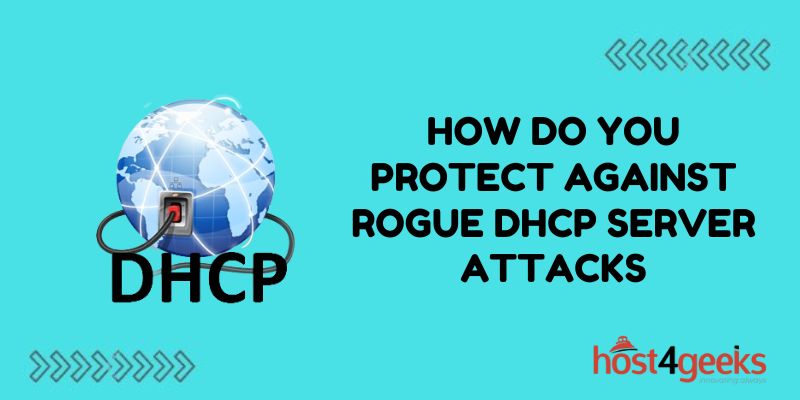Rogue DHCP servers can wreak havoc on networks by handing out incorrect network settings to devices. A malicious attacker can use a rogue DHCP server to carry out man-in-the-middle attacks, intercept sensitive data, and gain access to critical systems. Fortunately, there are steps network administrators can take to detect and prevent rogue DHCP server attacks.
What is a Rogue DHCP Server?
A DHCP (Dynamic Host Configuration Protocol) server automatically assigns IP addresses and other network settings to devices on a network. A legitimate DHCP server is crucial for easily adding new devices and managing IP addresses.
A rogue DHCP server is an unauthorized DHCP server installed on a network. Attackers can install rogue DHCP servers to intercept network traffic and manipulate network settings. By giving out incorrect configurations, an attacker can route traffic through their system for monitoring or manipulate network settings to cause denial-of-service.
How Rogue DHCP Servers Work
Rogue DHCP servers work by responding faster than the legitimate DHCP server to client requests. When a new device joins the network, it broadcasts a DHCP discovery request. Whichever DHCP server responds first to the request will provide the IP address and configuration to the client device.
Because rogue servers are only designed to provide addresses and not manage a pool of addresses, they can respond faster. If the rogue DHCP server responds first, all traffic from that client could flow through the attacker’s system.
Rogue DHCP Server Attack Signatures
Some signs your network may have a rogue DHCP server include:
- IP address conflicts arising from duplicate assignments
- Loss of connectivity for clients configured by the rogue server
- Unexplained traffic redirections
- DNS errors or unexpected domain assignments
More sophisticated attackers may attempt to remain stealthy when using a rogue DHCP server. In those cases, take proactive measures to detect rogue servers.
How to Detect Rogue DHCP Servers
To catch rogue DHCP activity, monitor your network vigilantly:
- Inspect DHCP Traffic: Use an IP addresses management tool to visualize DHCP traffic and highlight unauthorized servers.
- Packet Inspection: Inspect DHCP packets on switch ports to verify they originate from the correct server MAC address.
- Port Mirroring: Mirror switch ports to analyze DHCP traffic and watch for servers responding faster than expected.
- Analyze DHCP Servr Logs: Check activity logs on your authorized DHCP server to correlate eassigned IP addresses with hardware MAC addresses.
- Network Scanning: Scan for all DHCP servers running on network segments to map out devices.
Best Practices to Protect Against Rogue DHCP Servers
Along with detection, organizations should follow these DHCP server security best practices:
- Isolate Your DHCP Server – Use VLANs and ACLs to isolate your DHCP servers from general network traffic.
- Enable DHCP Snooping – DHCP snooping validates DHCP messages in Layer 2 switches to filter rogue server messages.
- Lower DHCP Lease Times – Shorter lease expiration places tighter controls on IP assignments.
- Disable Unused Switch Ports – Disable ports to prevent an attacker from plugging in a rogue server.
- Port Security – Port security limits which MAC addresses can communicate on switch ports.
- IP Source Guard – Filters IP traffic based on source MAC and IP addresses on each port.
- Static IP Mapping – Statically map authorized MAC addresses to assigned IP addresses.
How to Stop an Active Rogue DHCP Server Attack
If you confirm a rogue DHCP server on your network, take these steps to isolate it:
- Identify the port on which the rogue server resides.
- Disable the port if possible to sever communication.
- Locate and unplug the rogue DHCP server device.
- Ban the MAC address from the authorized DHCP server.
- Renew DHCP leases for existing clients to flush old configurations.
Rogue DHCP Server Prevention With 802.1X
Implementing 802.1X port-based authentication can strengthen protections against rogue DHCP servers in wired networks.
802.1X forces clients to authenticate through a RADIUS server before gaining network access. This authentication blocks unknown clients, like rogue DHCP servers, from connecting to network ports.
DHCP Server Protection on Wireless Networks
Wireless networks are especially vulnerable to rogue DHCP server attacks because it’s easy to intercept wireless traffic.
To protect against wireless rogue server threats:
- Implement wireless encryption via WPA
- Filter MAC addresses at the wireless access points
- Use SSID hiding and wireless isolation.
Final Thoughts
Rogue DHCP servers present a sneaky threat that can be hard to detect. However, with robust monitoring of DHCP activity, changes in traffic patterns, and IP addresses paired with restrictive port security policies, organizations can protect against false DHCP server attacks.
Implementing redundancies for critical infrastructure and enforcing technologies like 802.1X authentication and DHCP snooping also adds essential layers of protection. Rogue DHCP servers aim to create chaos, but staying vigilant of the warning signs, validating server behavior, and controlling network access enables IT teams to lock out these attacks.
Don’t allow your devices to fall victim to malicious configuration settings – by actively hunting for and blocking rogue DHCP activity, you can centrally manage all IP addressing with your authorized servers.

